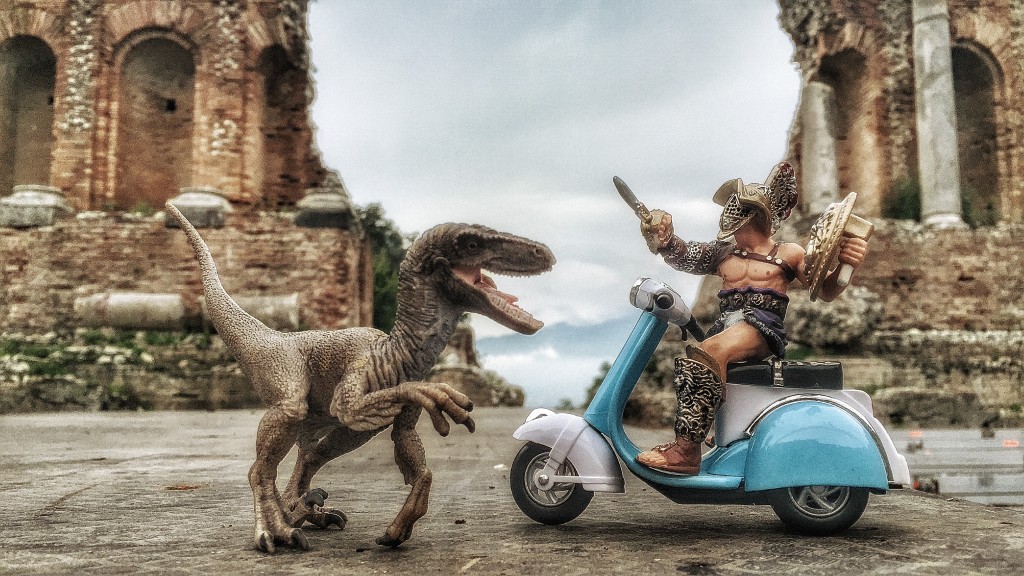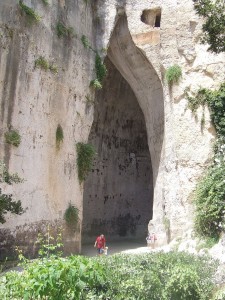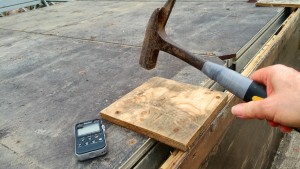I’ve just returned from a vacation to Southern Italy and Sicily. It was a nerdy scholarly tour, with an emphasis on ancient Greek archaeological sites. (There are apparently more and better preserved Greek ruins in Italy and Sicily than on the Greek peninsula.) It was terribly serious — my wife and I spent a lot of time photographing Roman play figurines in front of Greek ruins, adding the occasional dinosaur and Vespa, just to go the extra mile in pursuit of historical accuracy.

This is EXACTLY how it looked 2,400 years ago.
But I had also music on my mind. I can’t go 100 yards in Italy without flashing on some piece of trivia from my college music history days. You can barely turn around without bumping into La Scala or whatever. Nearly every town along the train tracks triggered some music-geek memory. “Lookit,” I’d blurt at my ever-patient wife. “Arezzo! That’s where the most important music theorist of the Middle Ages invented staff notation and conceived the Guidonian Hand!” (If you’re ever forced to travel with me, bring snug-fitting, noise-cancelling headphones.)
I’d been to Sicily a couple of times before, but only to Taormina and Siracusa in the east. This time we started in Palermo. (Man, I love that city! So vibrant, funky, and delicious.) We then worked east, stopping at one Greek or Roman ruin after another. My favorite, I think, was Selinunte, a vast city of 30,000 until those Ba’al-worshippin’ Carthaginians trashed the place around 400 B.C. The peak population was triple that of Pompeii (which I also just visited for the first time), but unlike those ruins, Selinunte is nearly tourist-free, and you can freely clamber over and through the remains of ancient homes.

The Ear of Dyonisius—or Spock? (Creative Commons photo by Laurel Lodged)
When we arrived at Siracusa, I had a mission: When I first visited some 35 years ago, I was, like most visitors, awed by the remarkable echoes within the Orecchio di Dionisio (“Ear of Dionysius”). This tall, narrow, S-shaped grotto is part of the limestone quarries into the hillside behind Siracusa’s famed Greek theater. which is also chiseled into solid limestone. The space produces a remarkable echo, a series of strong, clear slapbacks that melt into moist-sounding reverberation.
On this visit, I was armed to capture the sound as an impulse response so I could mimic the effect in software. I carried a small digital recorder and (on the advice of blog reader Shizmab Abaye, in reply to my last attempt to capture historic ambience) an old-fashioned clipboard with a spring loaded clip.
(I’ve written about impulse responses before. In a nutshell: You record a percussive sound in an ambient space, and then process the recording in software so that you can mimic the ambience after the fact—for example, make it sound like you’re playing guitar in an ancient limestone cavern. How does it work? Easy—magic!)
However, your recording needs to be as free of other noises as possible. When we got to the grotto, it was full of tourists, one of whom was singing.
It sounded beautiful. I felt like a shit for just wishing he’d shut up. He eventually did. When the cavern grew relatively quiet, I started snapping the clipboard and recording.
A week or so later I was back in the studio. I scoured the recordings for the clearest clipboard snaps with the least background noise, and dropped the resulting files into an IR reverb plug-in. (I used both Audio Ease’s Altiverb and Space Designer, the convolution reverb included with Apple’s Logic Pro.) I got the best result from a snap recorded about 10 feet from the clipboard. Here’s how it sounded when applied to a couple of spooky guitars (low-tuned classical and a Dobro played acoustically with EBow.)
It’s not a precise replica of the space (even a touch of background noise compromises the results), but it’s a cool, eerie reverb that definitely doesn’t sound like some factory preset.

Someone left this hammer just SITTING here! It’s like leaving a loaded gun where a monkey can grab it.
I also snagged some other evocative IRs. In Taormina, we visited the Greco-Roman theater. (I’d played a gig there with Tracy Chapman in 2006. It was amazing to perform on that ancient stage with Mt. Etna looming in the background! We stayed an extra day, and that evening Italy won the World Cup. The rioting that night put to shame the meager outpouring of emotion in my neighborhood when our local baseball franchise wins the World Series.)
Naturally, I’d forgotten my clipboard on my recent visit, but they were dismantling the performance stage at the end of the concert season, and some worker conveniently left a hammer and some planks just lying around. I tried capturing the reverb as heard from the stage, plus a stronger echo in one of the side archways providing access to the stage and seats.
Finally, a not-so-ancient ambience: In Sorrento we stayed at the Hotel Tramontano, a fusty, old-school place with a remarkable history. It was a regular stopping point on the 19th-century Grand Tour. Prior guests included Byron, Shelley, and Keats. Ibsen wrote Ghosts while camping out there. Ernesto de Curtis even composed that sodden Italian restaurant warhorse “Torna a Surreinto” while lounging on the clifftop balcony. (You may know the tune as Elvis Presely’s “Surrender.”) Amazingly, I was in this beautiful tourist town for three days and didn’t hear it once. Life can be kind.
Anyway, I captured a spooky reverb in one of the stairwells.
Besides having a couple of new sound design tools, I’ve also got unique souvenirs: Mediocre sound recordings to counterpoint all my mediocre photos!
Got an IR reverb plug-in? Want to try these out? Download them for free here. Then just drop them into your IR ’verb of choice.








awesome!! I lived in southern europe for several years and posts like this make me homesick. Eh, va be.
Great work on the IR! I was just thinking of other good IR candidate sites around the Med and there’s definitely a few that I’ll try to get back to and sample in the next couple years. Places like the Psychro Cave on Crete would be ‘epic’ just for the mythological implications (birthplace of Zeus). Drench an album in IR from sites like that and call it Paleometal…. that shit would sell! 🙂
Do you have — or have you checked out — Altiverb? Creator Arjen van der Schoot has invested years in harvesting immaculately recorded IRs from around the world, including many ancient sites, including Malta’s Hal Saflieni Hypogeum. (https://en.wikipedia.org/wiki/Hypogeum_of_Ħal-Saflieni)
oh yes, I’ve used Altiverb in other people’s studios, but I don’t have it myself… I loved it though and definitely need to get a copy. I wonder if he’s sampled the deafening amplitude and echo of a typical european neighborhood stone street echoing off the stone/brick walls at 3 AM while you’re trying to sleep. The clip clop of a solitary woman in heels walking down the sidewalk is loud enough to wake up an entire neighborhood. Ah, good times…
Captured some good sounds , very nice !
I’m glad the clipboard worked out. Easier to get on the plane than the starter pistol!
If you get direct signal from the “clack” in your recording it’s probably like having a dry mix level that you can’t remove, although I guess you could trim it off. I haven’t done anything with IR reverbs so don’t know. Is that how you go about it?
Joe, as always….THANX! The archway reverb sounds a little darker,slightly muffled.Have you done anything with the artillery emplacements,or ammo bunkers on the headlands?My apprentice,Jor Slick, used them for sampling many years ago, and got great results.Had to get permits from the GGNRA,but it was pretty easy.If Dowland had that Vespa, there’d be no contest….Al
This is so great–now that I’m using Max for Live (in Ableton Live Suite), I should be able to load impulses. BTW, did you know that you can download the impulse for the famous Dan Harpole cistern at Fort Worden? https://deeplistening.org/site/cisterntutorial
Absolutely love your idea of taking IR’s as souvenirs. Afraid I’m going to have to steal that 🙂
Thanks, Rob. I can’t claim it’s an original idea. I’ve been inspired by the work of Arjen Van der Schoot, the brains behind Audio Ease’s Altiverb. The best thing about that IR reverb program is the amazing and imaginative collection or reverbs gathered from around the world, including some highly unconventional spaces. He does it right, acquiring permission to access the spaces during quiet off-hours, using great gear, and recording from multiple positions. It’s a far cry from my guerrilla hack jobs! Still, you’re right — it IS a unique and practical souvenir. 🙂